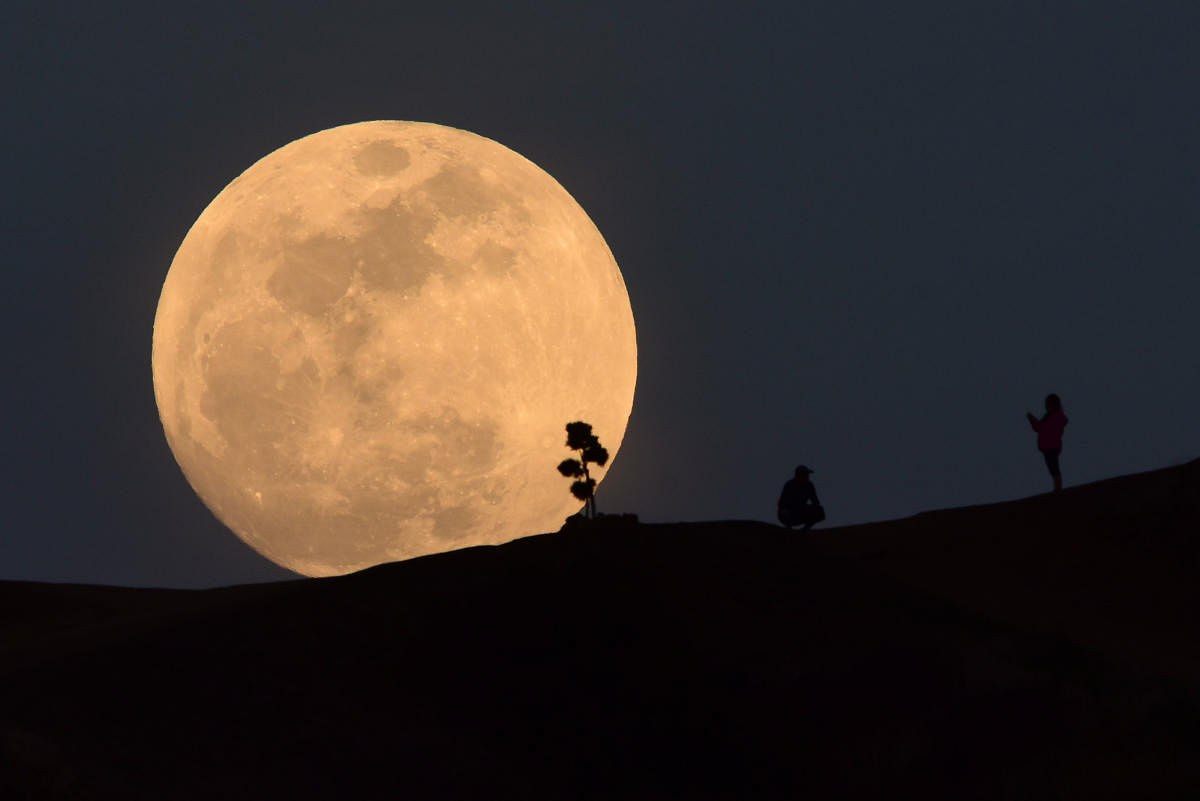
A peasant’s child
husking rice, pauses
to look at the moon
- Matsuo Basho
The nearest of all celestial bodies, the moon is man’s first cosmic muse. It has inspired the greatest of artists — from Haiku masters to Beethoven and Vincent van Gogh, waxing and waning, ever so radiant.
Mankind’s fascination for the moon is well depicted in a 1793 etching of the great poet-painter-printmaker William Blake, titled ‘I want! I want!’. The rather small engraving is perhaps the quintessential embodiment of the human longing for a deeper bond with the moon. It shows a human figure about to climb up a long ladder reaching out from the earth to a crescent moon, while two others look on.
A real manifestation of the unknown once, all kinds of associations were drawn to this peculiar object in the sky. Blake’s work, however, stands apart so vivid in its innocence.
With the opening up of the sciences post-Galileo and the moon landings just fifty years ago, the global mooning over was no longer benign curiosity. It metamorphosed into the greed to plunder — which some call moon capitalism today.
What Blake etched as the symbol of man’s earnest fascination is now a quest for water and minerals, not to mention space tourism for the filthy rich. I want! I want! Indeed.
In the East and West, the moon of the lore evoked amusing symbolism that rose from fear and reverence — from the vampires and werewolves to the lunatic asylum. A mystery object that could provoke profound psychic effects — in fact, a godhead. Nevertheless, the everlasting shine and beauty of the feminine form the moon embodies in imagery.
In Indian mythology, the moon is Chandra. We have rivers and a lake named after it, the Chandrabhaga rivers in the south and north, and the Chandrataal (The Lake of the Moon) in the Himalayas. The crescent moon adorns Shiva’s head and is the Hilal in Islam. The Man in the Moon legends, the rabbit, goddesses Diana and Selene of Roman and Greek mythologies, all were in fact celebrating the otherness of the moon that humans had subconsciously embraced in time. Moon symbolism was vogue, until science fiction took over.
Eventually, literature portrayed the moon as the coming of age of man’s scientific endeavors. In the works of Jules Verne, H G Wells and Philip K Dick, the underlying themes warn about man’s elephantine ego that blocks societal progress. Funnier ones appear too in modern times, when the Vogons blast the moon while destroying the earth and a Magrathean reconstruction ensues, in Douglas Adams’ The Hitchhiker’s Guide to the Galaxy.
Modern writers see the moon as a contextual reference to keep man wise, checking his vices. Like this passage from ‘I Cthulhu’, a short story in tribute to H P Lovecraft, written by the popular Neil Gaiman.
“I was spawned uncounted aeons ago, in the dark mists of Khhaa’yngnaiih (no, of course, I don’t know how to spell it. Write it as it sounds), of nameless nightmare parents, under a gibbous moon. It wasn’t the moon of this planet, of course, it was a real moon. On some nights it filled over half the sky and as it rose you could watch the crimson blood drip and trickle down its bloated face, staining it red, until at its height it bathed the swamps and towers
in a gory dead red light.”
In Stanley Kubrick’s 2001: A Space Odyssey, science fiction attained its glory. Soon, David Bowie’s Space Oddity would too with “the giant leap for mankind”, eclipsing great moon songs such as Pink Floyd’s Moonhead. In India, Lata Mangeshkar would render Chand Phir Nikla... to S D Burman’s minimal melody.
Man too had finally arrived on the moon by then.
Arguably the first media spectacle with at least 500 million people watching, the moon landing became the world’s first organised PR exercise. Even then, in a world still not plundered of resources, like at the moment, questions loomed large.
“When we landed on the moon, at the same time as we were celebrating humanity’s ability to push forward, by planting the American flag on the ground, suddenly it became a reflection of the Cold War...” American artist Matthew Day Jackson tells The White Review.
In the film Moon (2009) starring Sam Rockwell, director Duncan Jones explores a dystopian future where a replaceable human clone with a lifespan of three years mans a helium extracting facility on the moon for an earth-based corporation. The film unravels the existential trauma of the clone and his robot accomplice at a moon base.
As long as the moon was a motif of beauty and the sublime, it seemed alright. Now, in the hurry to seek celestial asylum when the earth’s resources are seemingly depleted, it appears to be the beginning of a scramble for survival — a brutal push in the time of the looming apocalypse.
In the middle ages, the moon was navigator, time-teller and calendar. Now, the moon is all about the aggressive exploration of moneyed corporations and the rising popularity for the generic visual appeal of the eclipses, blue moons, blood moons, super moons and so forth. And of course, our own Chandrayaan.